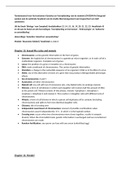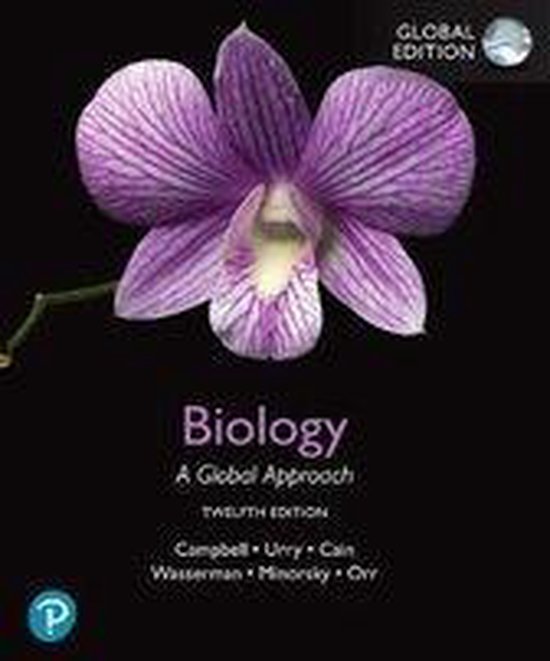Tentamenstof voor het tentamen Genetica en Voortplanting van de module LDM2DAVN (Integraal
werken aan de optimale houderij) van de studie Diermanagement aan Hogeschool van Hall
Larenstein:
Uit het boek ‘Biology’ van Campbell, hoofdstukken 13, 14, 15, 16, 19, 20, 21, 22, 23. Hoofdstuk 45
en 46 aan de hand van de hoorcolleges ‘Voortplanting en hormonen’, ‘Embryologie’ en ‘Geboorte
en ontwikkeling’.
Hoorcollege ‘Genetica: Inteelt en verwantschap’
Module ‘Duurzame fokkerij’ hoofdstuk 1, 2 en 4
Chapter 13: Sexual life cycles and meiosis
Chromosome: carries genetic information in the form of genes
Genome: the haploid set of chromosomes in a gamete pr micro-organism, or in each cell of a
multicellular organism. Complete set of genes.
Locus: the position of a gene or mutation on a chromosome
DNA: main constituent of chromosomes. The carrier of genetic information.
Mutation: a change in the nucleotide sequence of an organism’s DNA or in the RNA of a virus
Allele: any of the alternative versions of a gene that may produce distinguishable phenotypic
effects
Sex chromosomes: X and Y
Autosomes: all other chromosomes
Diploid cell: any cell with two chromosome sets, only diploid cells can undergo meiosis.
Meiosis: a form of cell division in which each daughter cell receives half the amount of DNA
as the parent cell. Meiosis consists of two phases, meiosis I (prophase I, metaphase I,
anaphase I, telophase I) and meiosis II. This results in 4 daughter cells with different sets of
chromosomes.
Mitosis: a form of cell division in which a parent cell duplicates all its contents (including
chromosomes) and splits to form two identical daughter cells.
Chiasma: site of crossing over
Independent assortment of chromosomes: amount of possible combinations when
chromosomes assort independently= 2^n , in which n is the haploid number.
Crossing over: occurs when two chromosomes move closer together, results in synapsis
(fusion). When the chromatids break, genetic information is exchanged and two recombinant
chromosomes are made.
Random fertilization: any sperm can fuse with any ovum (unfertilized egg)
Chapter 14: Mendel
, Mendel’s hypothesis: parents pass on discrete heritable units (genes)
Character: heritable feature that varies among individuals
Trait: variant for a character
Hybridization: crossing of two true-breeding individuals
P-generation: parent generation, true-breeding parents
F1-generation: first filial generation, the hybrid offspring
F2-generation: result of allowing hybrids to self-pollinate or cross-pollinate with other
hybrids
Dominant allele: allele that is fully expressed in the phenotype of a heterozygote
Recessive allele: allele whose phenotypic effect is not observed in a heterozygote
Homozygote: has a pair of identical alleles for a gene encoding a character
Heterozygote: has two different alleles for a gene encoding a character
Phenotype: visible appearance/traits
Genotype: genetic makeup
1st concept of Mendel’s model: alternative versions of genes (alleles)
2nd concept of Mendel’s model: Organism inherits two alleles, one from each parent
3rd concept of Mendel’s model: dominance (dominant and recessive allel)
4th concept of Mendel’s model: law of segregation
Law of segregation: the two alleles for a heritable character segregate during gamete
formation and end up in different gametes.
Testcross: breeding an organism with an unknown genotype with a recessive homozygote to
reveal the genotype
Dihybrid: individual that is heterozygote for two characters (YYRR x yyrr YyRr)
Dihybrid cross: a cross between F1 dihybrids
Complete dominance: phenotypes of the heterozygote and dominant homozygote are
indistinguishable
Incomplete dominance: neither allele is completely dominant and the F1-hybrid has a
phenotype somewhere between the two alleles
Pleiotropy: gene affects multiple traits
Polygenic inheritance: more than one gene affects a trait
Quantative characters: many characters are not one or two discrete characters, but vary in
the population
Genetic diseases: many genetic disorders are inherited in a recessive way and only show up
in homozygote recessive individuals. Carriers of a genetic disease (heterozygote) are
phenotypically not effected
Chapters 15+16: Inheritance
Morgan’s experiments





